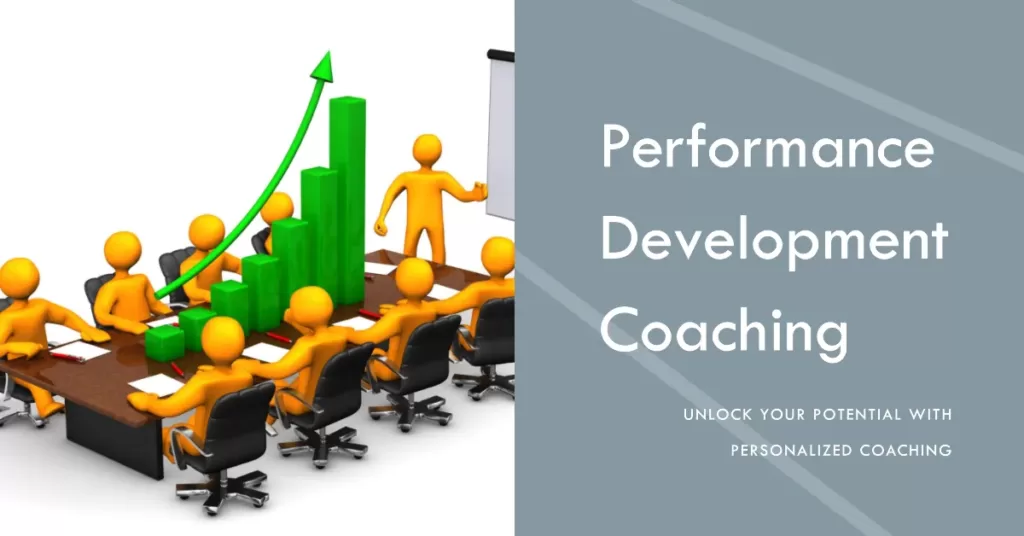Performance development coaching is a process that involves working with employees to improve their skills, knowledge, and abilities in order to enhance their performance and productivity. Coaching and performance go hand in hand, and effective performance coaching can lead to increased job satisfaction and better results for the organization. In fact, companies with strong coaching cultures report higher employee engagement and revenue growth. In this article, we will explore actionable tips and strategies for improving workplace productivity and job satisfaction through performance development coaching and a few sophisticated meditative techniques.
Read on to learn how to organize your workplace and improve productivity using mental training and other performance-enhancing strategies.
Table of Contents
- 1 Setting Goals for Performance Development Coaching
- 2 Providing Feedback for Performance Improvement
- 3 Developing Action Plans for Performance Improvement
- 4 Implementing Ongoing Coaching and Development
- 5 Measuring the Impact of Performance Development Coaching
- 6 Enhancing Employee Performance Through Mental Training
- 7 Mental Training for Effective Time Management in Leadership
- 8 Visualization: Insights from Brain Science
- 9 Significance of Mental Conditioning in Mental Energy Management
- 10 Conclusion
Setting Goals for Performance Development Coaching
Setting goals is an essential part of the coaching process. Goals provide a clear direction for employees and help them focus their efforts on what is most important. When setting goals for coaching, it is important to use the SMART goal setting framework. SMART stands for Specific, Measurable, Achievable, Relevant, and Time-bound. This framework ensures that goals are clear, achievable, and aligned with the organization’s objectives. Examples of effective goals for coaching include improving communication skills, increasing sales revenue, and enhancing customer service.
Providing Feedback for Performance Improvement
Feedback is a critical component of effective performance coaching. It helps employees understand how they are doing and what they need to do to improve. There are two types of feedback: positive and constructive. Positive feedback recognizes and reinforces good performance, while constructive feedback identifies areas for improvement. When giving feedback, it is important to be specific, timely, and actionable. Best practices for giving feedback include focusing on behaviors rather than personalities, using examples to illustrate points, and offering suggestions for improvement.
Developing Action Plans for Performance Improvement
Action plans are a roadmap for achieving goals. They outline the steps that employees need to take to improve their performance and achieve their objectives. An effective action plan should include specific actions, timelines, and resources needed to achieve the desired outcome. Examples of action plans for coaching include attending training sessions, practicing new skills, and seeking feedback from colleagues. It is important to develop an agreed action plan with the employee to ensure that they are committed to the process.
Implementing Ongoing Coaching and Development
Ongoing coaching and development are essential for maintaining and improving performance. It involves providing regular feedback, setting new goals, and identifying opportunities for growth and development. Strategies for incorporating coaching into daily work routines include scheduling regular check-ins, providing opportunities for skill-building, and encouraging self-reflection. Best practices for ongoing coaching and development include being supportive, providing resources and tools, and recognizing and rewarding progress.
Measuring the Impact of Performance Development Coaching
Measuring the impact of coaching is important for evaluating its effectiveness and identifying areas for improvement. Metrics for measuring coaching effectiveness include employee engagement, productivity, and performance metrics such as sales revenue or customer satisfaction. Examples of successful coaching programs and their impact include increased employee engagement, improved customer satisfaction, and higher revenue growth.
Enhancing Employee Performance Through Mental Training
In the contemporary business landscape, skills go beyond technical expertise. Mental training, rooted in psychology and cognitive science, is gaining traction as a potent performance enhancer. It equips employees with tools to navigate challenges resiliently, fostering adaptability. Techniques like meditation and deep breathing hone focus, amplifying productivity.
Workplace stress is a performance deterrent. Mental training techniques mitigate stressors, enabling composed performance. Emotional intelligence, nurtured by mental training, enriches interactions and teamwork. It aids in understanding and managing emotions, enhancing communication and collaboration.
Mental training dismantles self-limiting beliefs, boosting confidence. Positive self-affirmations and visualization breed self-efficacy, enabling the embracement of new challenges. In a dynamic market, adaptability is vital. Mental training fosters agility and creativity by fostering a flexible mindset.
Leadership flourishes with mental training. Emotional intelligence and decision-making prowess are honed. Leaders inspire teams, fostering a positive atmosphere. As businesses realize the connection between mental wellbeing and performance, investing in mental training becomes paramount. It nurtures resilience, focus, emotional intelligence, and adaptability, forging a workforce that excels, innovates, and propels the company forward.
Mental Training for Effective Time Management in Leadership
In the realm of leadership, time management is paramount. Mental training, rooted in psychology and cognitive science, emerges as a potent tool for leaders. It sharpens focus, aiding in priority setting. Techniques like mindfulness enhance concentration, enabling leaders to navigate a myriad of tasks.
Leaders make critical decisions under pressure. Mental training fosters resilience, enhancing decision-making. Visualization and controlled breathing maintain composure, leading to efficient choices. Stress often hampers productivity. Mental training equips leaders with stress-reduction strategies, preventing burnout.
Cognitive flexibility is vital in a dynamic landscape. Mental training fosters an open mindset, enabling agile problem-solving. Techniques like time-blocking optimize schedules, ensuring mindful task allocation. Goal visualization fuels motivation, aiding leaders in juggling multiple responsibilities.
As leadership’s pace accelerates, mental training is strategic. It empowers leaders to manage time effectively, make informed decisions, and cultivate a culture of productivity. Time management, leadership, and mental conditioning converge, creating a roadmap to success.
Visualization: Insights from Brain Science
Visualization, a meditative technique, offers a direct route to boosting productivity. Through vivid mental imagery, this practice engages brain processes that enhance performance. Brain science reveals the intricate connections between imagery training and improved work performance.
Neuroplasticity, the brain’s adaptability, is harnessed through visualization. Mentally rehearsing tasks rewires neural pathways, making execution smoother. Mirror neurons fire during visualization, mimicking real actions, heightening familiarity and ease of task completion.
Stress reduction and focus sharpening result from visualization. Imagining success releases rewarding neurotransmitters, easing stress. Visualization trains focus on precise actions, amplifying concentration when tasks are executed. It also triggers goal-oriented brain responses. Clearly picturing goals activates the brain’s reward system, escalating motivation. This motivation translates into heightened commitment, fueling productivity in goal attainment.
Various skills can be accelerated through imagery training. Athletes visualizing techniques show similar muscle patterns to physical practice. Similarly, visualizing work-related skills aids skill development, expediting proficiency.
The prefrontal cortex’s engagement is pivotal in visualization. Active during imagery, it aids in planning, decision-making, and goal setting. Regular practice strengthens this engagement, bolstering strategic planning and task execution.
In the world of work, visualization’s impact on brain performance is undeniable. Employing neuroplasticity, mirror neurons, stress management, and goal-driven motivation, visualization reshapes brain processes for optimized productivity. This cognitive tool holds the potential to redefine work performance, leading to enhanced productivity and success.
Significance of Mental Conditioning in Mental Energy Management
Mental conditioning is a linchpin in effective mental energy management. This practice involves shaping thought patterns, emotions, and behaviors to optimize mental resources. As mental energy is a finite yet vital resource, mental conditioning emerges as a strategic tool to harness its potential.
Mental conditioning helps cultivate self-awareness, enabling individuals to identify energy-draining patterns. Recognizing negative thought loops, stress triggers, and unproductive habits empowers conscious redirection of mental energy.
This practice bolsters emotional regulation. Mental conditioning equips individuals to manage emotions, preventing energy depletion due to emotional turmoil. It fosters resilience, enabling swift recovery from draining situations.
Mental conditioning practices nurture focus and attention control. In an era of constant distractions, training the mind to sustain attention prevents energy wastage. This laser focus enhances efficiency and conserves mental energy. It is crucial for employees trying to prevent burnout and optimize their performance – without effective mental energy management productivity becomes hard to attain.
Adopting positive mindset shifts is integral to mental conditioning. Pessimism and self-doubt drain mental energy. Mental conditioning replaces these with optimism and self-belief, fostering sustained energy levels.
Mental conditioning also optimizes decision-making. Clarity and mental agility are cultivated, streamlining choices. Effective decisions prevent mental fatigue from prolonged deliberation. It augments adaptability and encourages flexible thinking, reducing energy spent on resisting change. Adaptability, on the other hand, minimizes stress-induced energy depletion.
Mental energy, like physical energy, demands management. Mental conditioning serves as a toolkit for energy preservation. By rewiring thought patterns, managing emotions, enhancing focus, and promoting positivity, mental conditioning empowers individuals to harness their mental energy effectively. This practice propels individuals toward sustained vitality and optimal performance.
Conclusion
Performance development coaching is a powerful tool for improving workplace productivity and job satisfaction. By utilizing performance development coaching in combination with mental training, managers and HR professionals can drive performance in their organizations. It is important to remember that coaching is a process, and it takes time and effort to see results. By committing to a performance coaching program, organizations can create a culture of continuous improvement and achieve their objectives. For further learning, there are many resources available, including coaching training programs, mental performance training books, and online courses.




